Text
So I Want to Be a Game Designer #4 - Levelhead
Introduction
Hi. Welcome back to “So I Want to Be a Game Designer”! This week I will be analyzing Levelhead, a platformer designed for PC. I will specifically be analyzing the game’s level design to determine if it is able to successfully teach and engage the player.
Introduction of Game Mechanics
Levelhead begins with a cutscene for new players that describes the setting and objective. The cutscene is set in a business seminar that teaches “Employees” (i.e. the player) about the environment and what the player’s goal is, which is to control a GR-18 robot to make intergalactic deliveries.
During the cutscene, there is a moment when the player is shown a sleeping GR-18 unit. The player must click on the robot to initiate the “bonding sequence”, and this also causes the robot to shoot a magnetic “hook” out of its body. This smoothly introduces the correlation between pressing “Left-Click” and the resulting in-game behaviour even before the tutorial level loads.
The first level the player experiences is “Deliver The Package, GR-18!”. In this level, each new mechanic is introduced in small, digestible sections. This gives the player a chance to learn and experiment with the new mechanic without stress. Furthermore, players are also explicitly shown the new controls on-screen in a floating blue dialog. The introduction of each mechanic will be broken down individually:
Movement
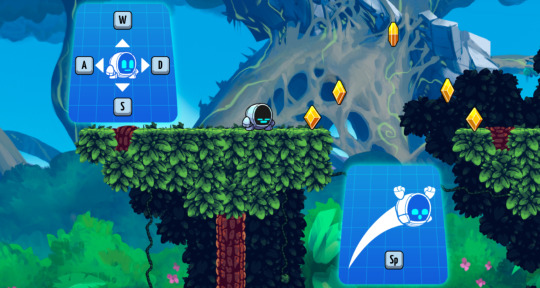
The WASD controls correspond to moving up, left, down, and right respectively. The player is given a small platform with no obstacles or enemies to get a feel for moving around.
Jumping
Jumping is introduced similarly. there are no enemies present to cause undue pressure. The way the level is designed in this brief, early section of the tutorial is meant to teach the player the different heights they are capable of jumping. For example, the first section can be cleared by only tapping on “Space” to jump, whereas the second part (with the 3 gems in a vertical line) requires the player to hold “Space” to jump higher.
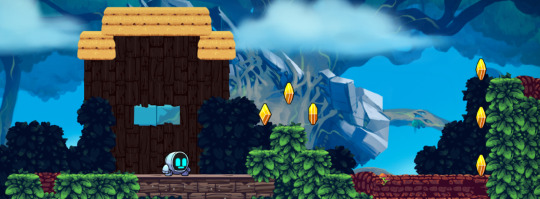
Crouching
The first time the player comes across the mechanic that allows them to drop through thin platforms the ability is signified by a bright blue arrow pointing downwards. Some players may have been able to intuit that they must press Down (“D”) due to the thinness of the platform and the abundant space beneath it. However, the addition of the arrow makes it significantly clearer for those who may not have ever played a platformer game.
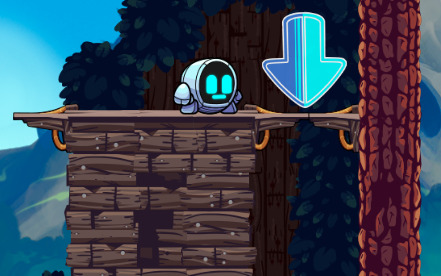
Enemies and Obstacles
The enemy is first encountered right after the first Checkpoint, in a small space in which the player can observe the enemy safely before choosing to engage. The enemy’s behaviour when it first sees the player is to attempt to charge at them. They are prevented from reaching the player by a Spike Block.
The fact that the checkpoint will reset the player right at that same spot and not at the beginning of the level also encourages players to experiment with how to avoid the Spike Blocks and defeat the Vacrat enemy without much penalty.

Grabbing & Kicking
As previously mentioned, the player is introduced to a mechanic in the cutscene that shoots a type of arm out of the GR-18’s body when they “Left-Click” on the mouse. This mechanic is re-introduced during the tutorial when the player needs to pick up the package cube. Like all other new controls, the player is shown a diagram in addition to the actual controls, such as “Left-Click” or “J”. Because the ability was indicated prior to the player reaching this point, the player may already know what to do. However, the diagram helps to explain the purpose behind the mechanic, which is to grab objects. Furthermore, not all players sit through cutscenes, so having another spot to teach those types is necessary.
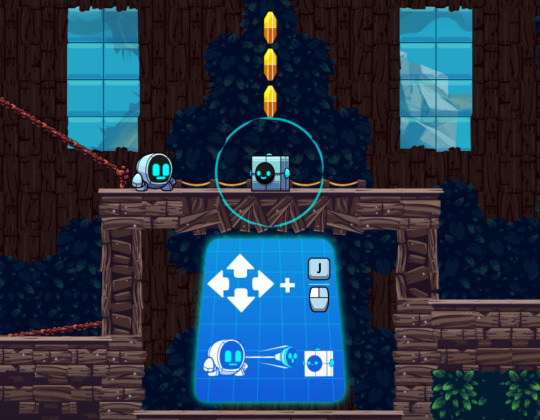
The Kicking mechanic is taught immediately after the player is taught how to Grab. The player is shown a magenta arrow pointing at the location the cube needs to be placed, and there is no way to get around this section without performing a Kick.
Kicking an object at an enemy is introduced shortly thereafter in another controlled section. There is a checkpoint that ensures the player can fail as many times as needed while they practice this new skill. Additionally, players can also learn that Kicking an object at an enemy can send them off a cliff.

Pressure Plates and Gates
An important mechanic later on in the game is the ability to leave the package behind on a pressure plate to activate some mechanism/clear an obstacle and return for the package later. In case the player isn’t able to intuit that their magnetic hook can pass through certain objects, the player is shown another diagram.
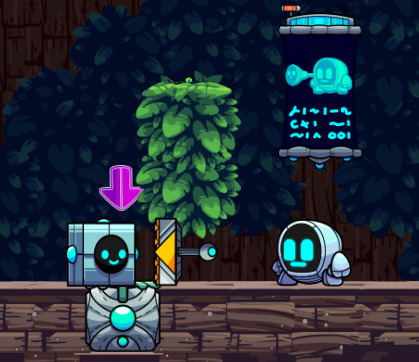
Player Skill and Engagement
The levels in Levelhead are designed quite well in terms of individual difficulty, teaching the player new skills, and helping them to master those skills. Even as a whole, the game is able to keep a good difficulty progression. As an example, let’s take a look at four consecutive levels: “Bop Jump”, “Dense Fog Ridge”, “Thorn Cloud Delivery”, and “Package Jump Temple”.
Bop Jump
The purpose of this level is to help the player practice their jumping skills, specifically on top of moving enemies.
The level starts out with a single enemy to jump on with spikes beneath it, and then it has a few easier rest sections.
Once the player gets to the next checkpoint, there is a section where the player is required to time their jumps properly to land on two moving enemies.
Another short “rest” section has the player practice the skill of picking up objects (a Key) and kicking it (to unlock a door).
There are two consecutive sections where the player must time their jump trajectories and timing properly; failing to do so results in a reset to the last checkpoint. This is the hardest part of the level. Once the player bests it, there is an easy jump section that leads to the exit.

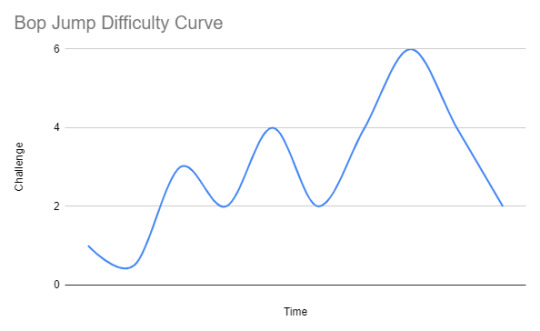
Dense Fog Ridge
The purpose of this level is to teach the player about how to handle jumping on clouds and springs. It is quite a bit shorter than the previous level, and its difficulty doesn’t fluctuate quite as much.
This level starts out with one simpler jump, and then it immediately proceeds into the section with the clouds. This is the most difficult portion of the map and the main point of it.
Afterwards, the player will have a lower-stress obstacle that simply requires a long jump the clear
Finally, the player can clear the level after completing a few spring jumps.
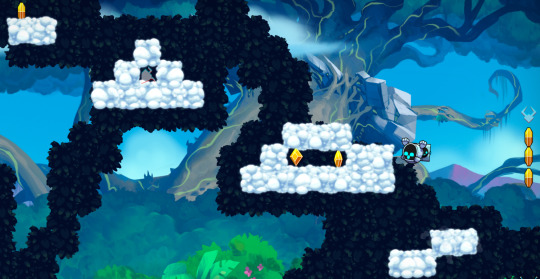

Thorn Cloud Delivery
This level is designed to teach the player a new skill: Using the package as a platform to gain jump height, then jumping and grabbing it from below while in the air.
Player must move a spring and time their jump to grab the package midair from an otherwise unreachable place.
The player moves through a cloud-jump section.
The player encounters the new skill, which may take a few tries to get right. In this section there is no danger of getting hurt.
The player reaches a checkpoint and encounters the hardest part of the section, which is to perform the new skill with spikes waiting below.
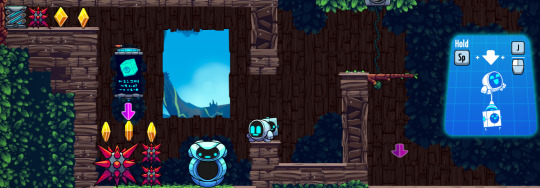
The player learns that clams make the player float in the next section
The player can exit the level after navigating a simple spike block
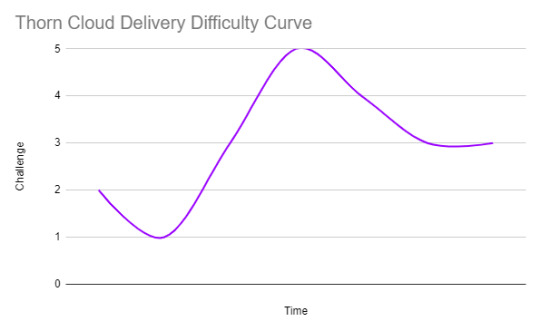
Package Jump Temple
The purpose of this level is to help the player master the Jump-Grab skill they learned in the previous level. Nearly every obstacle in this level can only be cleared by using that skill.
The first few times the player uses the Jump-Grab mechanic, there is no danger if they fail (e.g. no spikes below). The tricky thing is practicing the correct button-presses.
The hardest part of the level is making sure the player gets their timing and trajectory correct when picking up the package and jumping to safety.

The Player learns what a Rift is and that it teleports them if they move into it.
The player can exit the level after figuring out that they must throw/carry the package into the Rift, and then go back for the Key that unlocks the door.
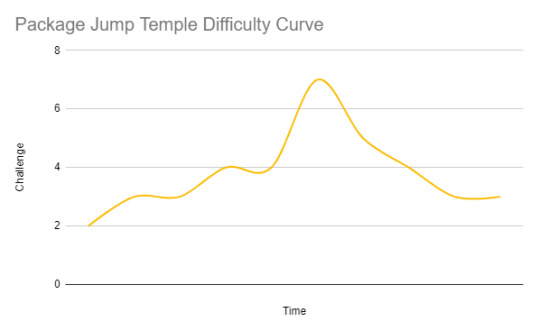
To consolidate all of this data, the levels follow a very similar trend in terms of difficulty. They all start out at a lower difficulty level, rise towards the middle, then ease up a bit at the end of the level.
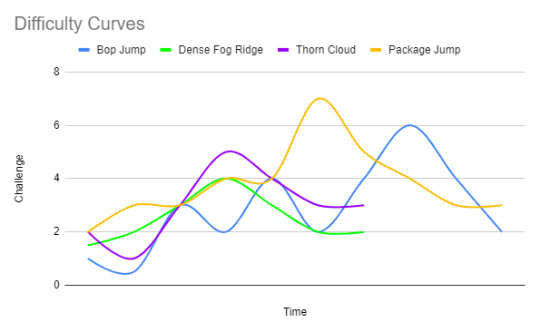
Another thing to note is that as the game progresses, each level begins at a higher difficulty than the previous one. Although this won’t always be the case, in general the game should become more difficult the farther into the game players get to keep them from getting bored.
Levelhead does this well. Players have a few shorter levels to test out newly learned mechanics, and then they can progress to a longer, more difficult level to test their mastery. The challenge that arises from a progressing difficulty is what keeps players engaged in the flow state.
Levelhead’s style of tactical immersion is perfect for their genre. They have obstacles that require the player to repeat the same mechanic multiple times throughout a level so that the player can learn, get better, and keep trying to challenge themselves.
Use of Affordances, Metaphors and Signifiers
Affordances
Levelhead has very good affordances in the game that help the player to instinctively know how to deal with specific obstacles and enemies due to the way they are designed.
Signs are used in the earlier levels whenever a new mechanic must be used. They demonstrate exactly what the player needs to be doing while they are just learning new skills.
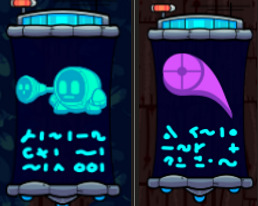
Vacrat enemies have red vacuum tubes that resemble ram horns and a red “bumper”. Both of these things afford that the player will take damage if they touch the front of the Vacrat. Conversely, the top of the Vacrat is flat and smooth, so it looks like it can be safely jumped on. These affordances help the player know how to deal with the enemy even without written instructions.

Spike Blocks are very clearly an object the player must avoid touching even at first glance. It has bright red, pulsing spikes surrounding the block. Even if the player has never played a game like Levelhead before, spikes are something players know are dangerous based on their real-world knowledge.
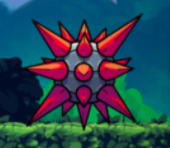
Breakable rocks have the grey colour commonly associated with stones in addition to looking fragmented and on the verge of breaking. This perceptible affordance immediately tells the player that they can break it. Knowing that the block can be broken, it would take the player only a brief amount of experimentation to discover they need to Kick an object at the rocks.

Hidden Affordances
There are hidden rooms scattered across the levels. Inside these rooms are extra gems and collectibles, so players who want to get 100% completion on each level will be required to locate these rooms. Many times there will be nothing (obvious) that shows the player is able to access these areas. The image below showcases one such hidden room:
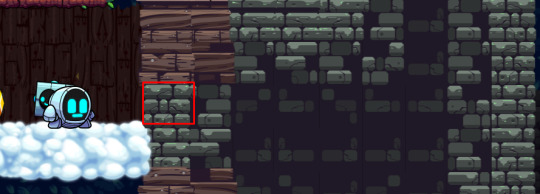

Having hidden affordances like this gives the game a challenging element that will appeal to types of players like Explorers and Achievers. It is an added feature that makes players who find them feel skilled and rewarded for their knowledge of the game.
Metaphors
Levelhead uses metaphors (in addition to affordances and signifiers) to help players understand how certain objects will behave in-game. Even without being told, people (hopefully) know that touching fire or sharp objects will hurt, clouds cannot literally be walked on, and gems are valuable. People will still maintain their existing knowledge of the real world while playing a game. Levelhead takes advantage of this by incorporating the expected attributes of objects like fire and clouds.
Fire
Damages the player
Cannot be walked through; must be avoided
Clouds
Float in the air
Disappear when stepped on
Gems
Are worth money in the real world
Give points when collected in-game
By incorporating these metaphors, Levelhead is able to create a smoother experience because players will instinctively know things about the game that make it easier for them to make choices.
Signifiers
The signifiers in Levelhead work in conjunction with affordances and metaphors to make the player’s potential actions or choices more discernible.
Arrows are a very common signifier (esp. in early levels) to indicate which direction the player needs to go.
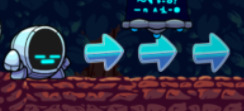
Grab-able objects all have a ring of magnetic waves surrounding them to signify that they can be picked up by the player
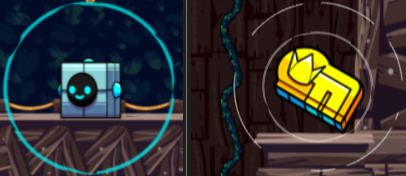
Light is used to signify when the player is able to successfully complete the level. If the player sees or approaches the exit without first retrieving the package, the exit teleporter is unlit and looks unimpressed. Once the player is carrying the package, the exit will light up with a beam that is visible from long distances and has a happy expression.

Nudging
Levelhead makes frequent and effective use of nudging to keep the player on the right track. They do this primarily with the use of breadcrumbing via gems. The player is encouraged to take a certain path by the way the gems are placed. This makes it easier for the player to know which way they need to go and potentially which actions they need to take. For example, the first time the player came across an enemy in the tutorial, there are gems in a vertical line above its head. This is a subtle indication that the player should jump on the enemy.

Another interesting example of nudging is the inclusion of platforms or spaces that don’t seem to have a purpose but actually lead to a hidden room. The leaves or blocks that hide the room from view only disappear if the player tries to walk through them. Players who pay special attention to these details will find hidden rooms easier to locate because of the subtle nudging, such as a platform that seems to lead nowhere.
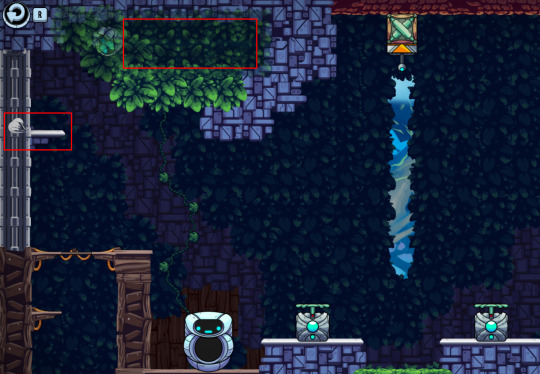
Priming
There are a few ways the player is primed in Levelhead. The first and most frequent is the appearance of Checkpoints. Checkpoints are placed right before or after a difficult section. For example, Checkpoints are frequently found before a jump section (like in the aforementioned “Pressure Point” level) where the player is likely to fail multiple times. This reduces the amount of frustration a player may feel when they fail, because they lose minimal progress by only being sent back to the Checkpoint just before their point of failure.
The other more prominent example of priming in Levelhead is rain. When it starts raining, the player quickly learns that it means a boss enemy is nearby that must be dealt with via combat or puzzle-solving. This gives them a chance to prepare or strategize.

Visual Design
Levelhead has some small but very nice animations and effects that enhance the player’s experience. For example, when players Jump, Kick, or Dash, there will be particle effects that appear on screen to give feedback that the action was successfully performed.
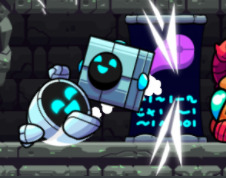
These effects give the user feedback for when they perform an action, and it’s this visual feedback that makes the outcome discernible to players. Because there is no haptic feedback for games played on Keyboard and Mouse, the difference in speed between walking and dashing isn’t very obvious without the effects.
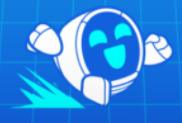
Conclusion
Levelhead has very well-designed levels that help to engage the player and keep them in a state of flow. The game achieves this by breaking levels down into sections that fairly closely follow an ideal difficulty/interest curve. That is to say that the levels have a good amount of challenge that rises and lowers throughout a level, as well as resting spots to let the player decompress.
The difficulty curve of both the overall game and each individual level flows fairly well. This keeps the challenge from becoming too much or too little, both of which cause players to lose interest in a game.
The objective of each level is clear, and with the aid of good affordances and visual design, the player receives direct and clear feedback for their actions. Whether its through animations, or audiovisual effects, the players actions are always made discernible. This discernibility prevents the player from feeling lost or confused, which would be detrimental to maintaining a state of flow.
Overall, Levelhead does a good job of keeping their target player audience engaged throughout the entire experience.
0 notes
Text
So I Want to Be a Game Designer #3 - Battle of Polytopia
Introduction
Hi. Welcome back to “So I Want to Be a Game Designer”! In this short installment, I will be analyzing a game to determine whether or not its design is able to support the various types of interactivity and choices. The game I will be analyzing in this post is Battle of Polytopia (BoP), a turn-based civilization strategy game designed for mobile on both Android and iOS.
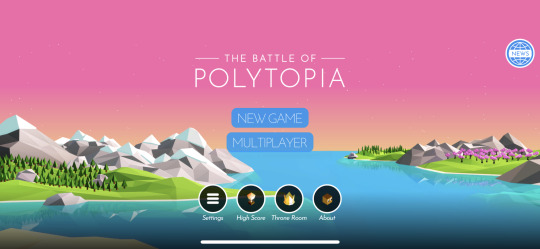
BoP has three single-player modes from which to choose: Perfection, Domination, and Creative. The “Perfection” Mode is limited to 30 rounds wherein the player aims to achieve the highest possible score. “Domination” has no turn limit; it ends only once the player successfully conquers all enemy civilizations. Finally, the “Creative” mode is fully customizable by the player. In this mode, the player can choose their tribe, the mode (Perfection or Domination), the number of opponents, the map size and type, and the difficulty level.
There are four types of tribes that are available for free; each one has its own starting perk on the Tech Tree (e.g. Baldur starts with “Hunting” whereas Xin-Xi starts with “Climbing”).

All of these aspects of BoP help to contribute towards different types of interactivity and offer the player different choices. In the next sections I will give examples of Cognitive, Functional, and Explicit Interactivity, as well as break down a few significant choices that can be made within the game.
Cognitive Interactivity
Encountering Enemy Civilizations

Something that BoP does well is engage the player in strategic gameplay. An in-game circumstance that supports this type of cognitive interactivity is when the player encounters a rival civilization. The player must strategize their approach by taking into account the number and type of enemy units as well as the number of enemy cities. The player will need to ask themselves: Should they spread their forces thin to try to do damage to as many enemies as possible all at once? Or should they instead focus on capturing one city within the enemy civilization in a concentrated effort?
This kind of cognitive interactivity is supported by the fact that the maps are randomly generated and that there are different unit types. Each game plays a little bit differently, so the player can still have a unique experience by encountering unexpected changes to the map layout. The player must also consider enemy damage and health in relation to their own units, so there are many strategic elements to engage in.
You Only Got 30 Rounds to Conquer the World
The player can aim for several goals when playing the 30-turns limit mode; two of which are trying to get the highest possible score or conquer all rival civilizations. Either of these pursuits are certainly a challenge because the player must master some skills and strategies to do them effectively. The player’s dedication/determination to reach either of these goals is a type of cognitive interactivity.
This type of mode would appeal to Achiever or Conqueror player types. When the player finishes the 30 rounds, they receive a score and a star rating out of 3 (50,000+ points are required for 3/3 stars). Their score is then put on the global leaderboard. These aspects alone are enough to spark the competitive nature of many players, which will cause them to play again and try to beat their personal high score or advance on the leaderboard.

Other players, like myself, want to conquer all rival civilizations within the 30 round limit. For example: During one of my play sessions, I had the unfortunate experience of being one round away from capturing the last enemy city after having defeated all enemy units, only to be thwarted by the 30-round limit. The thrill of being so close to victory and the frustration of not reaching my goal were large motivators toward trying again and again until I finally managed to do it. Personally, I think the 30-turn-limit mechanic and the resulting dynamics that encourage emotional engagement were excellent decisions that support this specific type of cognitive interactivity.
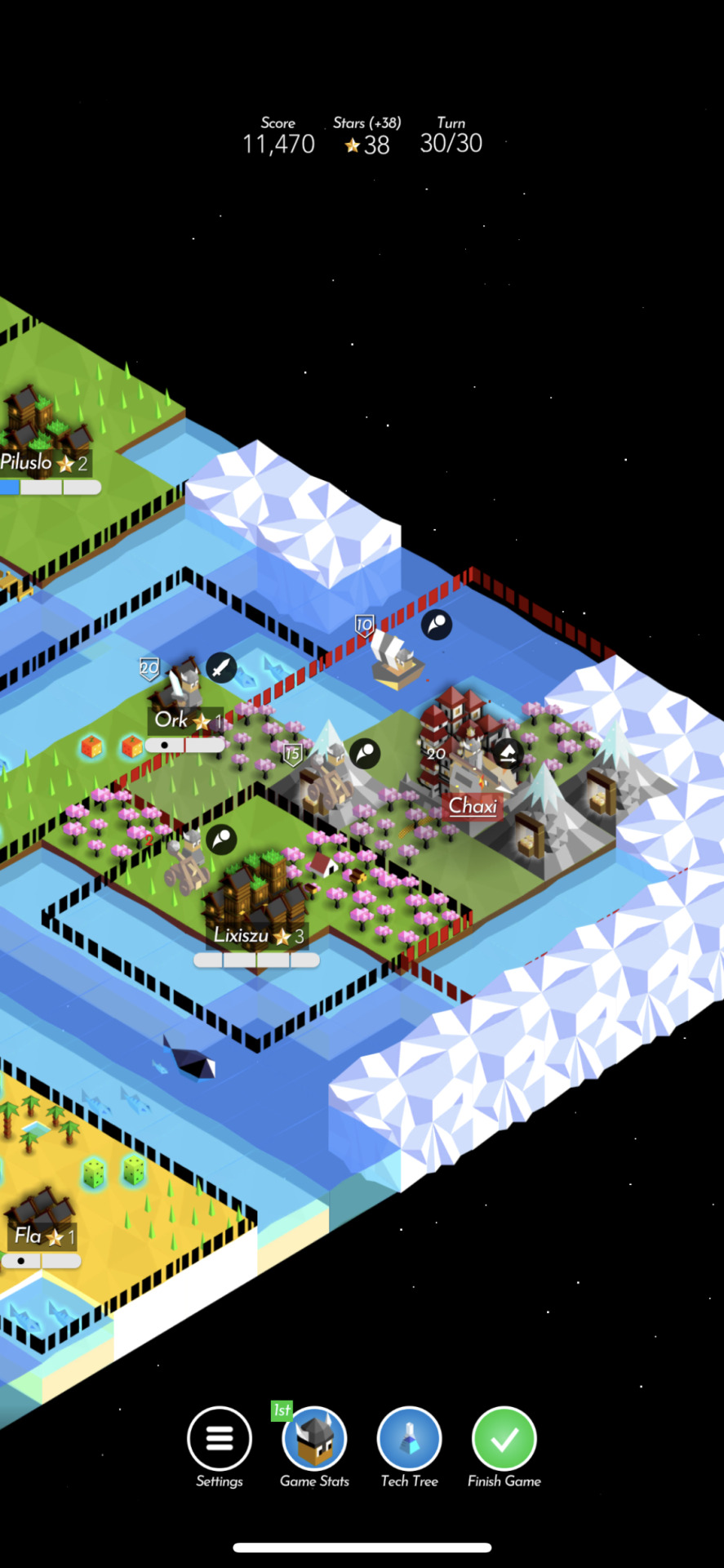
Watching Enemies Act
A type of passive interaction players may experience is the anticipation of enemy behaviour. When the player ends their turn, enemy units move around the map attacking the player’s units and capturing settlements or player-controlled cities. The player has no way of interfering during the enemies turn, so all that is left to do is watch the scene unfold.
This is a type of emotional interactivity. The player will do their best to predict where the enemy units will move/attack, so the player will move their own units accordingly. Once their turn is over, the player can only watch in suspense and horror as perhaps their carefully thought-out plan comes undone with the unexpected arrival of an enemy super soldier.
Players can engage in this sense of drama to have fun and become more invested in their current playthrough. Maybe the player tries to imagine their own narrative with a revenge plot, and that becomes their new goal of the game (instead of achieving a high score, for example).
Choosing Player Tribe
This allows the player to strategize even before the game starts. Players can look at which Tech Trees they like and/or which initial skill is best for their playstyle. Conversely, players can also choose their tribe simply based on visual aesthetics. Either way, the decision to incorporate different tribe types and abilities is supportive of both strategic and emotional interaction.
Functional Interactivity
1 - In-Game Icons
There are many little icons that need to be displayed on the map/on each unit so that the player knows what exactly they are (e.g. knight, sword, rider, etc.). These icons are also used to visually inform the player that a unit can be promoted (up arrow) or a recommended action (heart icon). These icons are overall very useful for helping the player know what to do next and to keep track of all of their various units. However, if there are too many units near one another, the display becomes very cluttered and it is hard to distinguish one icon from another or which unit the icon belongs to.

This is mostly an issue caused by the fact that the game is made for mobile, so the screen space is generally limited. A potential fix for this was somewhat implemented in the form of a UI Scale in the settings menu. The only downside is that the scale tends to make things take up too much room, so there isn’t really a happy medium at this point in time.
That said, the other icons that show when a unit is ready to be promoted or the little “sweat” symbols that appear when an enemy unit (visible in the above picture) can be killed by an attack are incredibly useful for strategizing.
2 - New Unit Menu
When the player presses on a city to create a new soldier unit, all available options will be displayed on a scrollable menu along the bottom of the screen. The player is still able to see and scroll the map (and what enemy types may be lying in wait), which might help them make a choice regarding which unit they want to train.

Allowing the player to continue viewing the entire map and enemy positions allows them to continue strategizing, so this was an important design decision. It also puts less pressure on the player to remember every little thing. Instead, the player can focus on the important gameplay mechanics due to the functional interactivity of the small unity menu anchored to the bottom of the screen.
3 - Off-Screen Combat Indicator
When the player ends a turn and the enemy units start fighting other AI units or the player’s units in an area not visible on the player’s screen, a red flare will appear on the screen in that direction.

This helps with the functional interactivity because it ensures that the player is immediately informed of a potentially game-changing situation. If the players were not informed that their non-visible units were being attacked, they may not be aware of what happened until a few rounds later when they try to implement new strategies. As a player, it would be incredibly frustrating to realize one of your cities was overtaken without being notified, and therefore being unable to prevent it or promptly retake the city. Thus, the visible but unobtrusive indicator for off-screen combat is extremely helpful.
4 - Movement and Attack Indicators
When the player taps on one of their units, blue circles show up on the tiles that unit can move onto. If a nearby enemy has a red circle under them, it means that they are within range of the player’s attacks.

These visual cues are necessary for the player to know how far each unit can travel/attack so that they can plan accordingly. Without them, it would be difficult to strategize and prepare on each turn.
5 - Field of View
The player can only see so far ahead of them on the map. This enables a feeling of suspense when the player must move their units to the edges of known territory without knowing if an enemy will suddenly appear right next to them.
Furthermore, it brings more value to other game mechanics such as the “Explorer” reward that can be selected once upgrading a city to a certain level. This reward reveals a significant chunk of the map so that the player can gain access to new resources and strategize more effectively.

Explicit Interactivity
1 - Gather Resources/Build
Players can collect resources by tapping on the tile on which the resource resides. For example, to collect fruit, make a lumber farm, mine, or fish, simply press on the tile to bring up a menu with all actions available for that tile. Then, the player must select the action they were intending, such as collecting fruit.
The developers seem to have made an updated design decision regarding when you can collect resources. When reading the description for collecting certain resources, it says that you have to be on the tile with the resource, but in actuality resources can be collected regardless of whether you have a unit on the tile or not.

I think this was a huge improvement to the apparent initial design. It can be a bit tricky to press on the tile below a unit in order to get the resource because of the lack of UI space on mobile screens. Now that players can collect resources from anywhere, the flow of the game is much smoother and the UI is less frustrating to interact with.
2 - Viewing the Map
Players can look at different parts of the map or the Tech Tree by swiping in the appropriate direction. This is very straightforward and expected of a mobile game. The map and Tech Tree can be a bit large (especially if the player has increased their UI Scale), so swiping along the screen allows them to look at specific aspects without having to zoom out and lose some of the details.
3 - Zoom In/Out on the Map
There can be a lot of details to take in on the map, and sometimes the player wants to see more or less of it. By “pinching” on the screen, the player can zoom in on the map to focus on a few specific tiles. Doing so will improve the visibility of icons and visual cues that are attached to units, cities, and other things on which an action is performed. Players may find it easier to take in information this way, which can help them strategize. Conversely, it is sometimes easier to strategize when more of the map is visible.
Significant Choices
The significant choices in the game will be broken down using the “Anatomy of a Choice” model, which is made up of the following components:
What happened before the player was given the choice?
How is the possibility of a choice conveyed?
How did the player make a choice?
What is the result of the choice?
How is the result conveyed to the player?
Choosing Which Technology to Research

The player thinks they have enough Stars to research new technology (which will unlock a new skill)
Once the player has enough Stars to research new technology in the Tech Tree, the icon used to navigate to the Tree will turn blue. The player now knows that they can upgrade a skill.
The player makes their choice by clicking on the technology they want to research. The process of making the choice is much more involved than that; the player would have some reason for wanting to upgrade a certain skill, which would help them decide which skill to upgrade in the first place. For example, the player wants Knights (units that are powerful and more mobile than others), but unlocking them first requires Hunting and Free Spirit. Knowing that, the player might choose to unlock Free Spirit as soon as it becomes available as opposed to another skill that has a similar or lesser unlock value.
Behind the scenes (i.e. in the backend), the player now has access to new methods and objects. Take unlocking Free Spirit as an example. The player gains the ability to build a temple (once constructed, gain points over time), clear a forest (instantly grant 2 stars), and to disband units (remove any existing units and get half of its cost in return).
A pop-up notification informs the player via text that they have acquired new technology. In addition, the skill’s previously greyed out icon in the Tech Tree becomes highlighted in green. Continuing the example of acquiring Free Spirit, the player would also see a new option show up if they were to click on an existing unit: “Disband”. Clicking on it would lead them into a separate choice, but the fact that it is there helps to properly convey the result of their choice to acquire the Free Spirit skill.

Choosing Your Reward After Upgrading a City

The player gathered resources or did some action (e.g. connect cities via roads, increase population, etc.) that increases the experience of the city
A menu pops up on the screen to inform the player that the city leveled up. The pop-up menu describes what gains it includes and explicitly describes that the player can choose an additional award, with two captioned images displayed beneath the message. The “additional rewards” are what the player can choose between, and they do not have any information additional to the image. For example, “Population Growth” and “Border Growth”.
The player presses on the image/icon of the reward they choose. The in-game state is updated. (The player has to learn from experience gained playing the game how exactly each of the rewards will alter their game)
The player receives more EXP/points, and the population of the city is increased or the area in which the player can build/gather resources is expanded.
Animated text messages pop up on the screen to display the increased EXP and added population to the city (Population Growth). Alternatively (if the player chose Border Growth), an animation that shows the player’s border expanding is played. The border is represented as a dotted line that matches the colour of the player’s tribe.

Conclusion
Battle of Polytopia is overall a decently fun turn-based strategy game. It has some great aspects to allow interactivity, but also some that need improvements. My main issue with this game is in regards to the way it handles choices (specifically when upgrading cities). BoP doesn’t really inform the player what the benefit of each choice is prior to presenting the choice. During my first playthrough, I simply guessed what each award did and hoped it was useful. I had to try to take note of the effects and remember them for later playthroughs, as the effect/result of my choice wasn’t conveyed very effectively (i.e. the discernibility needs improving). Especially during first playthroughs, players really have to pay attention to the description of things, such as what “population growth” is/means. If this was a deliberate design choice to promote more cognitive interactivity in the form of exploring options and learning via gameplay, then BoP did a fair job. If it was not, then perhaps my particular player type is suited to having information explicitly stated.
Other than that, I thought that the game supported some really great interactivity. The cognitive interactivity (strategizing, becoming invested in completing the 30-turn challenge, etc.) make the game very fun and engaging. A few of the functional interactions could be improved if the game moved off of a mobile platform or changed how clustered certain UI aspects were, but overall a lot of the visual cues that inform the player of when something important happened were spot-on.
0 notes
Text
So I Want to Be a Game Designer #2 - Kingdom Rush
Introduction
Hi. Welcome back to “So I Want to Be a Game Designer”! In this installment, I will be analyzing a game to determine whether or not its design is able to successfully engage its target audience. The game I will be analyzing in this post is Kingdom Rush (KR), a tower defense game designed for mobile on both Android and iOS.

Kingdom Rush is set in a medieval fantasy world in which the player is tasked with defending their kingdom against the forces of evil. The player has the ability to choose their Play Mode (Campaign, Endless, Challenge, etc.) as well as their difficulty.

The player’s objective is to build defensive towers to protect their camp from an onslaught of enemies who arrive in waves. Players can upgrade their towers to gain increased damage or helpful abilities, in addition to purchasing Skill Upgrades that can also boost their towers’ abilities.

In order to determine if KR is able to engage its target audience, I will first be identifying the target audience’s player profile.
Player Profile
The target player profile is made up of several things: the target player’s demographic, personality type, player type (i.e. using Bartle’s Taxonomy or the Demographic Game Design Model (DGD1)), and the player’s status as a hardcore or casual gamer.
Target Demographic
In general, Tower Defense games tend to cater predominantly towards males between the ages of 12 and 35 (https://thinkgaming.com/app-sales-data/genre/tower-defense/demographics/). In this regard KR is no different. Its stated age recommendation in the App Store is 12+, which I agree with due to the level of complexity of the gameplay. Because there are many towers and enemies whose abilities (strengths and weaknesses) the players must understand, players younger than 12 would most likely not have as enjoyable an experience.

Games that emphasize strategy and resource management are generally more appealing to males than females. KR has many of these aspects. For example, players must identify which towers are most effective against which enemies, keep track of multiple battles at once, and manage resources so that they can build more towers and upgrade existing ones.
Given that KR’s age demographic is primarily between the ages of 12 and 24 (with a slightly smaller but still prominent player-base aged up to 35), the marital status and income is more discernible. Target players will likely be single (i.e. unmarried) and have a varying yearly income between nothing at all and 60k per year. The broad range of income is due to the fact that some players will be too young to be able or willing to work (12-19), and others who may have graduated from post-secondary education and have a steady career, or the beginnings of one (20-35).
For Hardcore or Casual Players?
The definition of “hardcore” and “casual” is taken from 21st Century Game Design by Chris Bateman and Richard Boon. In their definition, a hardcore player is defined by someone who frequently partakes in longer play sessions, can tolerate complex controls, and makes buying and playing many games a high priority in their day-to-day lives. Conversely, casual players prefer shorter play sessions, have less tolerance for complex controls, do not prioritize games in their daily lives, and put emphasis on having fun when they do play games.
Based on these definitions, KR is designed primarily for casual players. KR is level/stage-based, so it makes the game playable in short sessions which typically last an average of 25 minutes. KR also has an “endless” mode so that players can play as little or as long as they want and not feel like they are abandoning an objective. The game’s controls are also very straightforward: the player taps anything they want to interact with. Interactable elements are clearly marked and easy to press on.
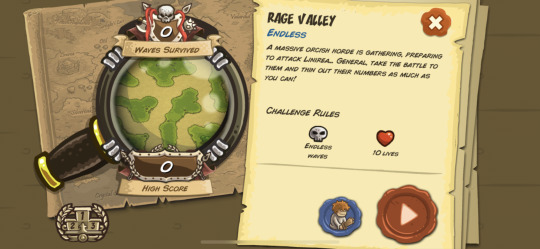
Additionally, KR has a simple narrative that is easy to remember and not the main focus of the game. This combined with its stage-based design makes it easy for players to pick up and put down the game whenever they want without feeling like they’re missing out. This is important because in my experience, if I put down a game that is heavy on narrative and attempt to play it again later, I will feel too lost in the story to have fun or want to continue playing.
To expand on that, players who don’t play as frequently don’t have to be overly concerned about forgetting details about the game. The Encyclopedia feature allows players to review information about towers and enemies. This is excellent for players who don’t spend enough time playing to memorize these enemy attributes (or don’t care to memorize them). Before a play session, the player can do a quick review so that they won’t be disadvantaged or become frustrated when returning for a short play session.
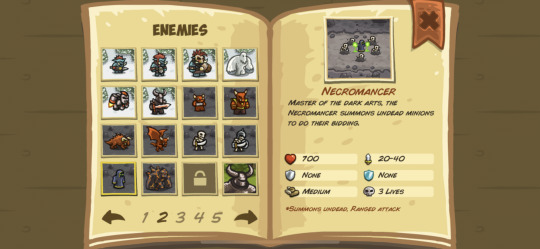
Finally, players can choose their difficulty for each stage, and it can be changed at any time. This allows players to scale the game to their own skill level. Because casual players generally don’t have a lot of time they are able or willing to dedicate to games, they are more likely to stop playing a game if the difficulty isn’t engaging for them. This could mean either becoming bored from the game being too easy, or being too frustrated if the game is too difficult.

Player Type/Playstyle
KR is primarily designed for the DGD1 Player Type 2: The Manager. Manager’s are mostly concerned with coming up with the best strategies to beat the game. They enjoy analyzing and understanding how the game works in order to come up with logical solutions to in-game problems. They generally don’t mind having to replay a stage if it means they can improve on their strategy, and they are always striving to improve their mastery over the game. Managers like a steady progression of challenges, so that they can improve their skills without feeling like the game is too difficult to overcome.
(The following “codes” or sub-characteristics are from this blog: https://incobalt.wordpress.com/2012/01/22/player-taxonomies-reviewing-the-dgd1-model/)
Strategy
Different types of towers and enemies require the player to analyze the strengths and weaknesses of each (especially in relation to one another) in order to come up with a viable strategy for winning a stage.
At the beginning of each level, the player has an infinite amount of time before the first wave spawns to come up with their initial strategy. They can observe the layout of the map, what types of enemies will spawn, and the available positions for towers.
Skills boost different resources available to the player (e.g. archers can gain increased fire rate, reinforcements can gain better health and armour, etc.) and can be used to develop different types of strategic gameplay.
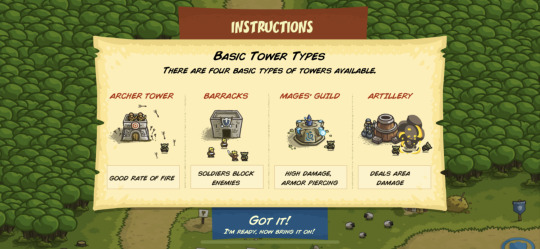
Mastery
Players can earn up to 3 stars on a given stage. Their star rating is determined by the number of lives they have left once all enemy waves are defeated. This star rating is usually used by players to indicate how well they have mastered the game (or a particular level), so it is a motivating factor for Managers. This also ties into the Replay and Patience aspect of Manager types.
Process
Whenever something new is introduced to the player (tower type/upgrade, enemy type, etc.), the player will be given a short description so that they have some idea on how to incorporate it into their strategy
The Encyclopedia feature allows the player to review information about towers and enemies. It also has a section for Tips.
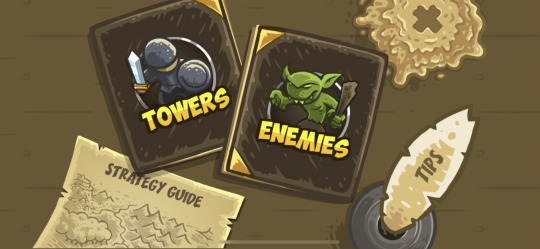
Replay
The Star rating in KR encourages players to replay stages until they receive 3 stars (which gives them a sense of achievement and also allows them to purchase Skill Upgrades).
Once the player earns 3 stars on a stage, they unlock a new challenge mode for the stage. There are a total of 3 modes per stage. This allows the player to continue learning the game and improving their skills and strategies.
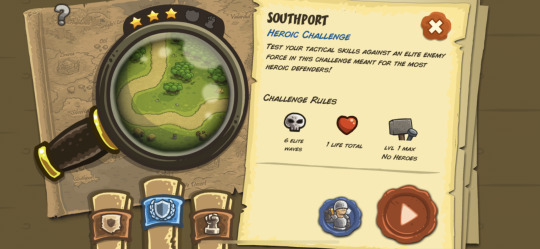
Patience
Since Managers prioritize strategy and mastery, they are usually willing to accept trial and error. In KR, some stages can be tricky and introduce unexpected elements during the level. The player can easily restart a stage or play it again after learning and testing out new strategies.
Challenge
KR has 3 difficulties to choose from. They can be changed per stage and at any time. This allows the player to scale the difficulty to their skill level. In this way, players can prevent the game from becoming too challenging to overcome with their strategies (which is most important to them).
Building
The player can unlock certain Heroes with different abilities to freely control. Because each Hero has different attributes, they can select the one that best suits their strategy.
Skill Upgrades can be purchased with the Stars earned by successfully completing a stage. The Skills the player chooses to prioritize will affect the effectiveness of certain towers, which again ties into their ability to strategize.
Gems can be used to buy special items that can be used to give the player an advantage.
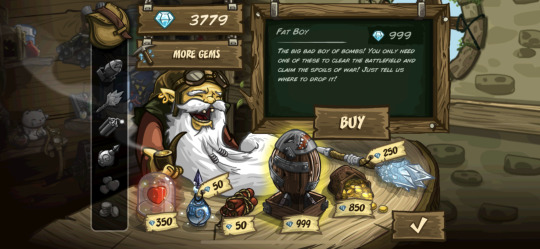
Personality Type
The personality traits listed hereafter refer to the Myers-Briggs Type Indicator (https://en.wikipedia.org/wiki/Myers%E2%80%93Briggs_Type_Indicator).
Introversion
Players have an infinite amount of time to plan their strategy before the first wave begins, which ties into introverts’ tendency to think first and act later.
Because they are motivated internally and are more concerned with their own thoughts and ideas, introverts will like the single-player strategy aspect of KR.
Sensing
Tower and enemy attributes (strengths and weaknesses) are clear. They can also be reviewed at any time in the game’s Encyclopedia.
The player can recall details from previous playthroughs in order to optimize their current strategy.
Thinking
Takes an objective and detached approach: The player analyzes the position of towers and enemy spawn points and then selects which towers to build based on effectiveness, not how much they may like their abilities or aesthetics.
Uses facts and logic in decision-making process: Certain enemy types are strong/weak to certain towers the player can use, so the player can keep all this information in mind when deciding which towers to build, where, and when.
Perceiving, while on the verge of Judging
Adaptive: Players might have to change their strategy quickly to deal with unexpected enemy types or numbers (especially during the first playthrough of the stage).
Multitasking: After the first few levels of the game, the player must divide their attention between two or more lanes from which the enemies will spawn. This will require them to keep track of their overall resources and distribute them accordingly. The only way they can achieve this is by managing multiple tasks at once.
(Judging) Approaching with a definitive plan of action: Most players will look at the map layout, enemy spawn zones and initial enemy types prior to beginning the match in order to determine their initial action plan.
Player Motivation
I will be measuring the player’s motivation in terms of Leblanc’s Game Pleasures. The type of player KR is designed for will be mostly motivated by the Challenge and Discovery aesthetics. They will enjoy learning about the game and how to form the best strategies to test their skills in each level.
Challenge
The player must try to beat the levels, which become increasingly harder as you progress (within each difficult rank).
The player tries to get 3 stars (the maximum) on every level, which is more of a challenge than just beating the level itself.
Once a stage is completed with 3 stars, a new challenge mode is unlocked for that level. The player will have additional constraints during challenge modes, so it will test their game mastery and strategies.
Discovery
The player has many game mechanics to explore and strategies to learn/come up with. For example, new enemy types and how to counter them.
Tying It Together: Target Audience
Let’s summarize everything thus far into one coherent description of Kingdom Rush’s target audience. KR is a game designed for casual gamers between the ages of twelve and thirty-five. These players will likely be predominantly male, and they will be what the DGD1 model classifies as a Manager. KR will be best enjoyed by strategic-minded players who enjoy objectively reviewing the game to come up with the best plan of attack for completing a stage.
Player Engagement
Now that the target audience (player profile) has been identified, it is time to determine if KR has aspects that can successfully engage the player. There were many design decisions that were made to support the player profile, such as the MDAs and the way KR facilitates decision-making and meaningful play.
Mechanics
Tower Types
Enemy Types
Enemy Strengths and Weaknesses (which correspond to different towers)
In-level currency for building/upgrading towers
Skill Tree - upgrade skills to receive different buffs
Dynamics
Players must analyze the flow of the current level and the enemy types that are spawning to gather necessary information for later decision-making
Pre-round planning: based on the types and spawning areas of the first wave of enemies, where do they prioritize resources? (E.g. Start with one heavily upgraded Soldier tower on one lane and two less-upgraded Soldier towers on the other, place Archers where they expect magic-resistant enemies and Mage towers where they expect armoured enemies, etc.)

Determine which towers to use, and which of the two upgrade paths they should use. (E.g. Archers: Fast fire rate, lower damage with the later option to poison enemies? Or Sharp shooters that have slower fire rate but do significantly more damage with the ability to potentially one-shot an enemy?
Determine where to place towers in order to group enemies in specific places or deal with certain enemy types.
Decide on the Hero support (does the player want the long range Hero so that they can deal with pesky enemy archers and do damage from afar at the cost of lower survivability? Do they want to use a tank that can be used to power through tougher enemies or large groups of mobs at the cost of speed/maneuverability? Or do they want to have a more versatile Hero that can provide support all over the map with faster movement speed and more consistent health and damage output?
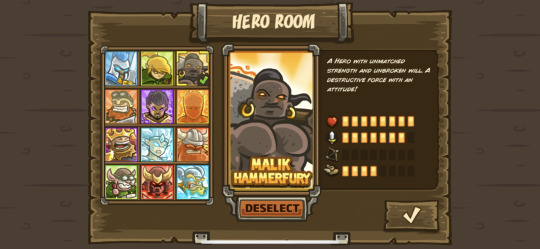
Skill Tree upgrade priority: what is their playstyle (e.g. Player relies on meteors a lot, so that should be upgraded early on)? Which towers do they find the most useful/use the most?
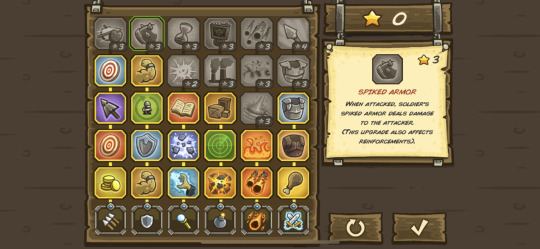
Map awareness: players must multitask. Keep track of the state of their own towers, which areas are struggling, if enemies are breaking through their defenses, where enemies will spawn next, etc.
Should the player start a new wave early to earn more resources? Or are their defenses too taxed to handle more enemies before the previous wave is done? (E.g. If you know that the next wave is all flying enemies that can’t be reached by your melee troops, consider: do you have enough Archers to handle the onslaught of flying enemies? If so, spawning the wave early will grant extra resources. If you don’t have enough Archers or you aren’t confident, is it instead more worthwhile to kill all remaining enemies to gather enough resources to build more archers/upgrade current ones?)
All of these dynamics heavily tie into the previously mentioned Manager player type. The player can engage in all of these dynamics and more in order to have fun playing the game.
Aesthetics/Game Pleasures
The easily alterable difficulty level allows the player to create enough of a challenge for themselves that they are able to enjoy the game and come back for more. Both Manager player types and casual players can tend to quit a game if they become too bored or frustrated. The ability to change the game’s difficulty depending on their current skill level (perhaps after not playing for a bit or for a certain tricky stage) will keep the player engaged in play: they can increase the difficulty if they become too bored or decrease the difficulty if they become too frustrated.
There is lots to learn about the different aspects of the game (towers, enemies, skills, etc.).The player can utilize all of these aspects to discover different strategies by replaying a stage. Manager-type players love this type of learn-improve-succeed cycle.
Meaningful Play/Decision-making
The player’s choices are very meaningful in KR. The level can become smoother or more difficult depending on their choice of tower construction. Players will primarily be of the Manager type, so they will enjoy feeling the impact of their choices (winning or losing the level) and learn from the experience.
The player can form longer term strategies by investing in certain Skill Upgrades, which will make them feel that their choices have a more integrated impact on their game.
Additional Aspects
Players will be more casual than hardcore, so the fact that the controls are a straightforward and easy to understand will keep the players from becoming frustrated due to lack of understanding.
Additionally, levels are designed to be relatively short in order to make the game palatable to its casual target audience.
Conclusion
Kingdom Rush is designed quite well for its target audience. So many of its mechanics and dynamics make the game really fun for their primary player type (The Manager), such as the various ways to strategize and improve. The fact that the difficulty can be easily changed is an excellent feature for casual players that are motivated by Challenge aesthetics. With that said, there is no obvious change I think KR needs to make to their design. They quite successfully engaged their target audience and were able to make a fun game that can be picked up and put down at their leisure.

0 notes
Text
So I Want to Be a Game Designer #1 - Once Upon a Tower
Introduction
Hello, reader.
Welcome to a new series, “So I Want to Be a Game Designer”! In this series, I will be analyzing a game to identify its mechanics, dynamics and aesthetics to determine if the game successfully facilitates Meaningful Play.
The game I will be analyzing in this post is Once Upon a Tower, a roguelike game designed for mobile on both Android and iOS. In this game, you are a princess who has been detained at the top of a tower. When a knight’s failed attempt to rescue the princess results in her gaining a weapon, she uses the weapon to facilitate her escape from the tower and the evil dragon who guards her.

While this game has a straightforward objective, there are many aspects that work together to make the game challenging and fun. In the following sections, I will be covering the game’s:
Core Loop
Mechanics
Dynamics
Aesthetics
Meaningful Play
Core Loop
The core loop consists of the main activities that players will use continually throughout the game. In Once Upon a Time, those core activities can be boiled down to two things:

Every action the player might take on their quest to escape the tower (i.e. descend) can be encompassed by the term “overcoming obstacles.” As the player makes their way through each level, they must destroy blocks in their way, avoid or defeat enemies, and perhaps collect fireflies and purchase power-ups. No matter how the player chooses to go about navigating the level, the fact that they must overcome obstacles remains.
Likewise, after overcoming the obstacles in their way (no matter how they choose to do it), the player must then descend the tower. This is the goal of the game, and an action that will be repeated throughout its entirety.
Mechanics
Mechanics are game rules that are designed to constrain and influence the player’s actions within the game so that it is played as intended. There are three main types of mechanics:
Space Mechanics - has to do with the environment
Object Mechanics - things within the environment that can be seen or interacted with
Action Mechanics - things the player can do
Core Mechanics
The core mechanics are those that are fundamental to the player’s experience; without these, the game would be completely different.
Gravity (Space Mechanic)
The character falls through open spaces in the map to progress through the level
Swinging the Weapon (Action Mechanic)
Serves several functions: breaking blocks, collecting fireflies (currency), and attacking enemies
The action of swinging the weapon is integral to the core gameplay because the player cannot progress without at least breaking blocks
Levels (Space Mechanic)
The only way the player can progress through the game and win it is by advancing through the levels. Without the level structure, the game would be fundamentally different
Non-Core Mechanics
The non-core mechanics, while important for furthering the core theme, are those that the game can exist without if they were to be replaced. For example, the enemies do not have to be dragons and ogres; they could be replaced with zombies and skeletons and the core of the game would remain the same.
Space Mechanics
Barred Windows - A space in the tower walls that the dragon will breathe fire through to attack the player. The player cannot interact with them, so they aren’t really an “object” in the game. The effect of the dragon attacking through them is activated when the player stands on the same horizontal plane as the metal bars.

Object Mechanics

Bricks - An obstacle the player must destroy to progress through the level
Rubble - Weak blocks that will crumble when the player stands on them, causing the player to fall through (usually to traps waiting below)
Spikes - An obstacle that kills the player when landed on (without certain power-ups)
Piston - An obstacle that periodically pistons a log vertically or horizontally to crush the player if they do not time their movements correctly
Power-ups - Purchased with fireflies between levels
Defensive buffs to prevent damage from attacks or obstacles (e.g. the armoured boots will prevent damage from landing on spikes or crabs (who have spikes on their backs))
Offensive buffs will augment the player’s weapon or give them an extra ability (e.g. the fire hammer will give the player ranged attacks, or bombs will destroy enemies and obstacles on a large scale)
Other buffs will aid in the players traversal of the obstacle course (e.g. the parachute slows down the character’s fall and allows movement when descending
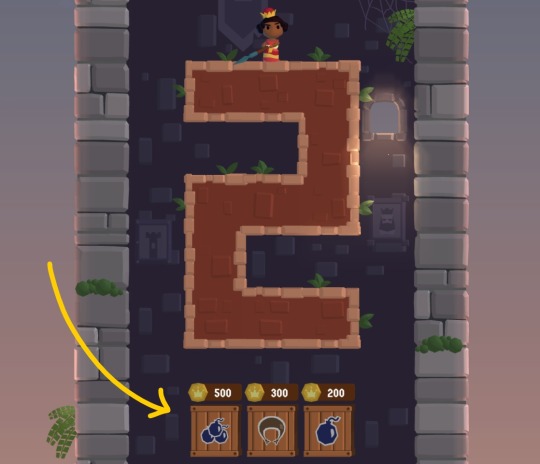
Fireflies - in-game currency and points. During a level, the player can use collected fireflies to purchase power-ups. After exiting a level, the fireflies earned will be converted into stored points which can unlock new character avatars.
Diverse Enemies - Each enemy has unique behaviour, and require different strategies for countering them:
Ogre
Hyena
Spider
Crab
Baby Dragon
Action Mechanics
Movement - The player moves one block at a time by the player swiping in any direction on their screen (left, right, up, and down)
Swiping Left or Right: Moves the character one space in the indicated direction
Swiping Up: Causes the player to jump and swing their weapon at the space above their head
Swiping Down: Causes the player to break the block in the space beneath them (if there is one), which is how they can utilize gravity to descend the tower
Dynamics
These are the ways players can utilize the mechanics to play the game; i.e. the gameplay. Dynamics include strategies the players can develop based on different game mechanics.
Timing
The player needs to select the right moment to break blocks or move past obstacles to avoid getting caught

Utilizing Enemies
Some enemies will fight each other if close enough together. Players can attempt to turn them against each other by pushing them closer with hay bales or breaking blocks
Managing Currency
Do you buy a powerup now or save it for more expensive items in later levels?
Spatial Reasoning
The player must be aware of their surroundings so that they can properly react to obstacles (especially the dragon, which will breathe fire through barred windows)
Collection
Do you prioritize collecting fireflies in order to get power-ups? Or do you ignore them in favour of taking out enemies at a more advantageous time?
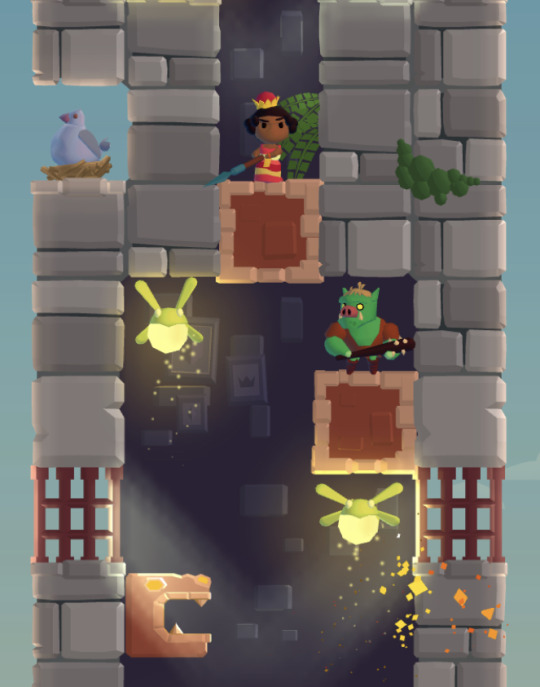
Aesthetics
Once Upon a Tower is primarily trying to engage the player’s competitive spirit and sense of discovery. Many of the game's mechanics and dynamics are ideal for players who enjoy a challenge and like playing to beat their best score.
Challenge
The player is issued a high score at the end of each play session, so they are encouraged to play again to beat their own score
Obstacles are tricky, so when the player is bested by a level, they are left with the competitive urge to try again until they can overcome it
Escape progress (beating all the levels) is tracked per princess. This encourages players to continue playing the game with each princess to feel the satisfaction of “100% completion”, which can be considered as completely beating the game
(No noticeable narrative to interfere with a competitive player’s desire to get right into the gameplay)
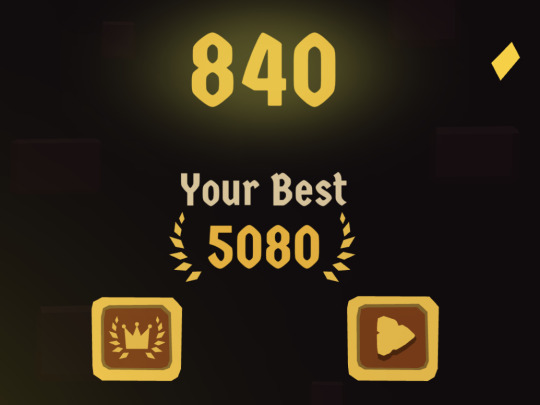
Fantasy
The game is set in a fantastical environment with mythical medieval enemies (such as dragons and ogres)
The cartoon style of the graphics keep the game feeling whimsical and fun, so that the player will not be distracted from the core gameplay
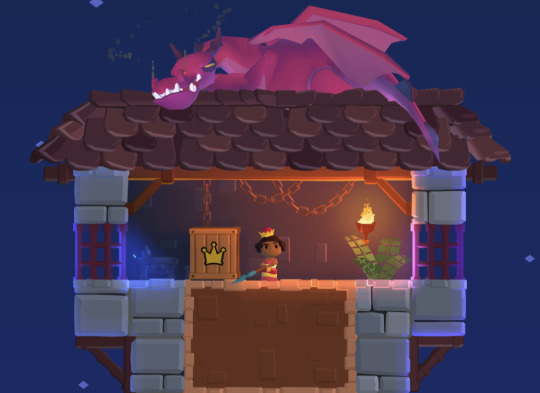
Discovery
The player is constantly learning new things during each playthrough and each level. Every time the player restarts at the top of the tower, the layout is regenerated for a fresh experience. Furthermore, as the player goes from one level to the next, they will encounter new enemies and obstacles to overcome.
Once Upon a Tower has a colourful, cartoon-like art style typical of indie games. The art style fits well with the medieval fantasy setting, so that the player can be immersed in the simple narrative of a princess trying to escape a tower.
The style of the art and animations upon defeat are very lighthearted. This keeps with the primary theme of keeping the player engaged in the challenge aspect of the gameplay, rather than a tragic narrative. The game is meant to be something that can be picked up and played immediately, not something that requires the player’s focus on uncovering a complex story. The upbeat background music and sound effects only add to the player’s feeling of lighthearted fun.

Meaningful Play?
“Meaningful play occurs when the relationships between actions and outcomes in a game are both discernable and integrated into the larger context of the game. Creating meaningful play is the goal of successful game design.” —Salen, K., & Zimmerman, E. (2004). Chapter 3: Meaningful Play. In Rules of Play: Game Design Fundamentals (pp. 4–4). essay, The MIT Press.
The game mechanics and dynamics in Once Upon a Tower are able to achieve meaningful play in several regards. For example, the blocks the player chooses to break (i.e. the route they choose) to navigate the level can determine whether they can collect fireflies or safely overcome obstacles. Collecting enough fireflies will allow the player to purchase power-ups between levels. Certain power-ups will make the later levels much easier to complete, such as armoured boots or a shield, which is why the player’s decision to collect fireflies in the early levels and save them for purchasing more powerful buffs will have an integrated effect on their gameplay.
The medieval fantasy setting of the game was a good choice considering that gravity was a core mechanic. Any tall building world works well with the concept of the game. However, the aesthetic genres are able to work in conjunction to create a game environment that makes sense. The fantasy setting facilitates the use of the castle tower as well as the designers’ creativity when choosing monsters and obstacles. These obstacles are what turn the game into something challenging, and the diversity among them is what allows the player to explore uncharted territory.
The combination of all the aforementioned mechanics, dynamics, and aesthetics certainly do give rise to meaningful play.
Conclusion
Once Upon a Tower is a game that is able to facilitate Meaningful Play by a combination of its mechanics, dynamics, aesthetics, and overall design decisions. For those who have a competitive nature, this game will likely prove to be an addicting pastime due to the challenge it poses. Many of the game's mechanics, such as the obstacles, diverse enemy types, and the level-based structure of the game will keep the player engaged. The use of upbeat music and colourful visuals give the game a sense of lightheartedness that will immerse the player in the role of a plucky princess trying to escape a tower against all odds.
Credits: All screenshots are of in-game elements from Once Upon a Tower. I claim no ownership over the image contents or the game itself.
1 note
·
View note